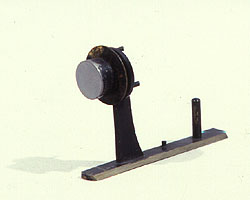 39. Gregorian telescope by Dollond
39. Gregorian telescope by Dollond
In Optica Promota (London, 1663), James Gregory (Aberdeen 1638-1675) had launched the idea, already conceived of in 1661, of replacing the object lens with a concave mirror, or rather two concave mirrors (the larger parabolic, the smaller eliptic) parallel and coaxial, with coinciding focal planes, in the form that took its name from him - Gregorian [file 35].
This instrument - signed Dollond. London - cost £36, or 865 Bolognese lire, as can be seen from the original bill of sale of the Rubini brothers to the Administrators of the Institute, dated 5 October 1788, discovered in the Archives of the Department of Astronomy (busta XXVIII).
It is described together with its accessories in the inventory of 1843:
"Gregorian telescope 2.4 feet long with parallel mirrors in brass tube 4 inches in diameter, with direct image eye-piece [Inv. MdS-68], which crosses the big mirror: work of Dollond. Stand and metal support with two handles for small movements.While there are many XVIIIth-century refracting telescopes still able to provide excellent images, this is only rarely the case with reflectors. This is because of the degradability of the mirrors - which at that time were not made of glass but worked in a special bronze called "speculum" - and the difficulty of mechanically adjusting the optical parts. This exemplar, perhaps because it was used so little, still furnishes good quality images when used with the 80 enlargements provided by the surviving eye-piece.
There is a second eye-piece for this instrument with greater magnification [Inv. MdS-135], and a second small spare mirror [Inv. MdS-48], kept in its own metal box.
Each eye-piece has a colored glass with brass frame.
Three metal pieces purpose-built and screwed to the table top underneath, keep the feet of the instrument fastened to it.
A metal cover that closes the aperture of the telescope.
Sturdy walnut table [Inv. MdS-160], of similar shape to preceding one [triangular, supported by three legs tied together by a lower board], which serves to support the Gregorian Telescope."
E. Baiada, A. Braccesi (1983), p. 123.
M. Daumas (1953), p. 315.
G. L’E. Turner (1981).